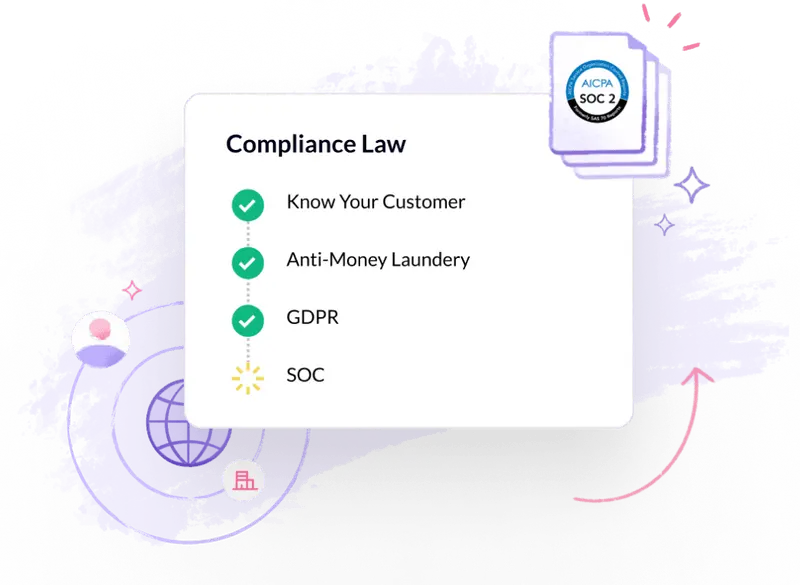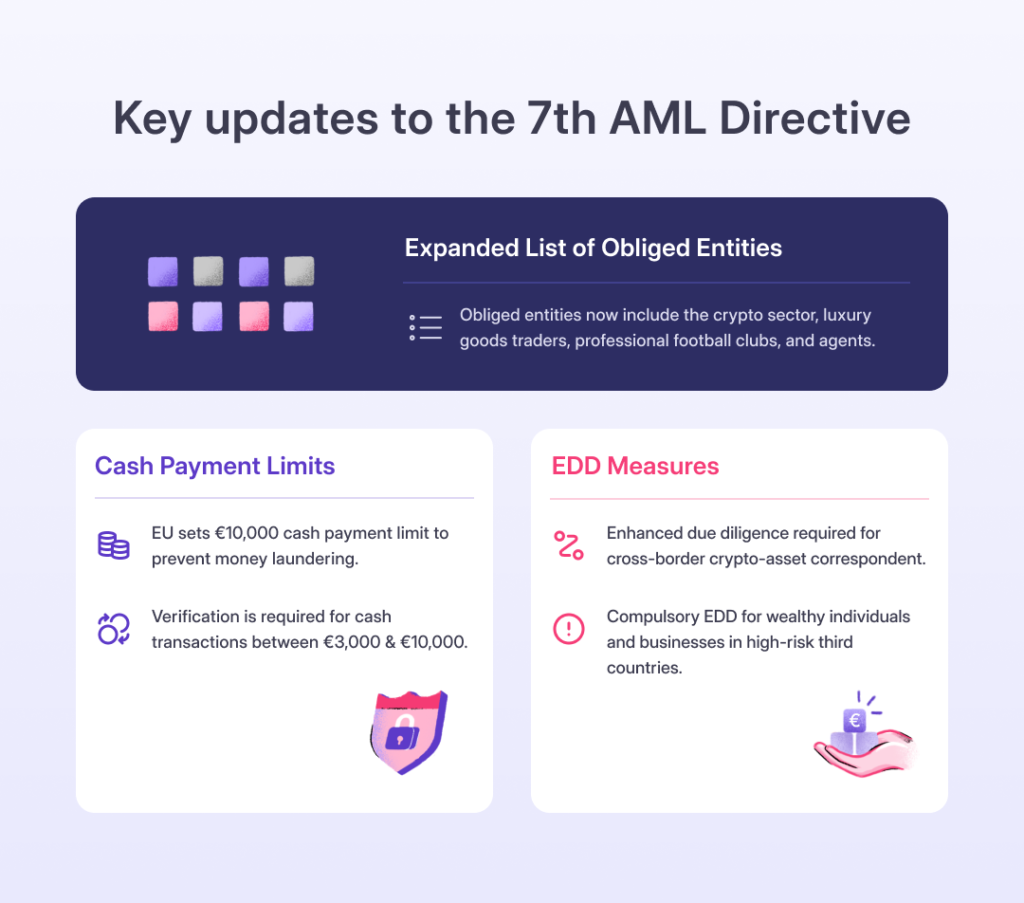The fast-paced advancements in technology have made global financial systems vulnerable to the risk of money laundering and terrorist financing activities. The member states of the European Union have taken this risk into cognizance and have taken proactive steps to address anti-money laundering (AML) deficiencies. They have established specific AML and KYC(Know Your Customer) compliance requirements through anti-money laundering directives (AMLD).
The anti-money laundering directives are promulgated by the European Parliament as a part of the domestic legislation for its member states. The first AMLD was introduced in 1991 and has been updated over the past three decades to include new regulations. These regulatory compliances have been appended to strengthen the framework to fight money laundering and terrorist financing.
What is the Anti-Money Laundering Directive?
Money laundering crimes have become a cause for concern with the rising instances of such crimes. Data reveals that approximately 100 billion Euros are laundered in Germany annually!
It is a financial crime that involves disguising the illicit funds generated through criminal activities like human trafficking, drug trafficking, trade of illegal weapons, terrorist financing, etc., as legitimate funds. Money launderers move money through a series of complex financial transactions to deceive financial authorities.
The AML directive is a set of regulatory obligations established by EU member states that a financial system must comply with to prevent money laundering and terrorist financing.
The implementation of AML directives is supervised by the European Central Bank (ECB), which addresses laundering and terrorist financing concerns that impact the safety of the institution.
By implementing anti-money and laundering directives, financial establishments can identify and report suspicious transactions and protect them from legal and reputational risks.
The History of all EU AMLDs
A total of seven anti-money laundering directives were issued by the European Parliament to address laundering and terrorism financing in the European Union.
AMLD 1
The first AML directive issued by member state governments was issued on June 10th, 1991. It mandated member states to define the laundering of money as a criminal activity. According to the first money laundering directive, specific anti-money laundering responsibilities were assigned to certain segments of the private sector.
However, the regulatory scope of anti-money laundering Directive 1 was limited, and it only focused on banks and financial establishments. It could not counter-terrorist financing for illegal activities like weapons smuggling. Hence, the first AML directive was updated to overcome the limitations of AMLD 1 and increase the scope of AML.
AMLD 2
The Anti-Money Laundering Directive 2 was introduced after the 9/11 attacks in December 2001. The regulatory scope of the second anti-money laundering directive included AML compliance requirements for various obliged entities like lawyers, notaries, auditors, external accountants, and tax advisors.
AMLD 2 took into account that besides financial institutions, financial criminals were using institutions like Money Services Bureaus (MSBs) grouped under Non-Banking Financial Institutions (NBFIs) to legitimize illegal funds.
AMLD 3
The third directive was introduced in 2005 to address the “War on Terror.” AMLD 3 was directed by the UK Terrorism Acts of 2000 and 2003 and the revised recommendations of the Financial Activity Task Force (FATF).
The third directive introduced stricter AML measures, including simple due diligence and enhanced due diligence. This imposed restrictions on entities from offering services to individuals and institutions identified as having terror links. It included a risk-based approach in AML compliance and emphasized aspects like the client’s credit risk profile, industry, and service. AML directive 3 was the first to mandate competent authorities to introduce penalties for breaches in AML compliance.
AMLD 4
The fourth money laundering directive was issued by the anti-money laundering authority of the European Union in 2015. The EU member states were directed to integrate the fourth AML directive into their national laws by June 2017. The domestic legislation of the fourth AML directive extended to sectors like gambling-based firms. Unlike the previous directives that focused chiefly on terrorism financing, AMLD 4 emphasized bringing transparency in areas like tax crimes, bribery, corruption, etc., to reduce the avenues for financial criminals to conceal themselves. The fourth AML directive covered foreign nationals and politically affiliated entities as well.
AMLD 5
The EU anti-money laundering Directive 5 was introduced in 2018. According to Directive 5, it was mandatory for EU member states to perform customer due diligence on clients from high-risk countries.
The fifth directive restricted money launderers from using channels like prepaid cards, crypto exchanges, exchange of high-value goods, ultimate beneficial ownership for money laundering, and terrorist financing. AML directive 5 includes risks related to the anonymous use of virtual currency and prepaid cards. It defined a legal description for cryptocurrencies and crypto exchange. The directive also recommended regulations on the exchange of high-value goods like arms, oil, precious metals, and more. It mandated that the ultimate beneficial ownership should be made transparent.
AMLD 6
The sixth directive was introduced in June 2018 with the mandate to member states to implement it by June 2021. The sixth EU anti-money laundering directive standardized the existing AML practices prescribed by the European Parliament.
According to the sixth anti-money laundering directive, criminal liability is extended to entities who assist or aid/abet money launderers in laundering and terrorist financing. Hence, the relevant authorities had to include domestic legislation for the detection and prevention of aiding and abetting laundering crimes in addition to the regulations covered in the previous directives.
AMLD 6 formalizes 22 predicate offenses, including smuggling, forgery, counterfeiting or currency, environmental crime, and more, as crimes associated with laundering.
AMLD 7
It is the latest AML directive that increases the power of Financial Intelligence Units (FIUs) and strives to enhance cooperation between them. It was introduced in July 2021.
Key Highlights of the New AMLD

The following are the key highlights according to the EU anti-money laundering directives of AMLD 7.
Expanded List of Obliged Entities
The agreement broadens the category of obliged entities to include the crypto sector, luxury goods traders, professional football clubs, and agents.
High-Risk Third Countries
Anti-money laundering supervisors must ensure enhanced due diligence measures for transactions and business relationships involving high-risk countries, identified based on assessments by the Financial Action Task Force (FATF).
Refer to our complete guide to high-risk third countries here.
Cash Payment Limits
AML directive 7 also requires the member states to impose limits on cash transactions with a threshold level of €10,000. Transactions surpassing this amount will be identified as financial crime and lead to criminal liability.
Member states have the flexibility to impose a lower maximum limit if desired. Obliged entities must identify and verify individuals conducting occasional cash transactions between €3,000 and €10,000.
Supervision and Risk Assessment
Each member state ensures effective supervision of obliged entities through a risk-based approach, along with reporting suspicions to Financial Intelligence Units (FIUs).
Enhanced Due Diligence Measures
It builds a consistent regulatory environment with the crypto travel rule to prevent terrorist financing risks through online transactions involving cryptocurrency.
Financial institutions need to comply with enhanced customer due diligence requirements for business relationship with high-net-worth individuals handling significant assets.
Enhanced Transparency
According to the seventh directive, the member states need to create central records of ultimate beneficial ownership data and it should be publicly accessible to make it transparent.
Counter Risks Posed By Virtual Currency
Member states must ensure that the facilitators of exchange between virtual and fiat currencies, custodian wallet providers, etc. are registered and subject to AML/CFT supervision.
Criminalization of Money Laundering
It updates the regulatory obligations of the previous directives to mandate the member states to criminalize laundering of money as a criminal offense. This implies that the EU member states must establish laws to criminalize laundering and terrorist activities.
Risk-based Approach
The directive promulgates a risk-based directive in the implementation of anti-money laundering. The objective of the risk-based approach is to conduct risk assessments to prevent laundering and terrorist financing in the crypto space.
Ensuring AML compliance can be complicated. Fortunately, there are automation tools that help streamline AML compliance. There is a myriad of AML solutions providers across the globe. HyperVerge is one of the leading AML solutions providers across the globe.

Stay Compliant with EU AMLDs
HyperVerge provides AI-based AML screening and monitoring solutions that conduct risk assessments and provide suspicious activity reports that help businesses identify and mitigate AML directive compliance risks. Our AML solutions provide you with a comprehensive view of customer risk identification. These insights empower you to make informed decisions and adhere to the AML legal compliance directives. Our AI-powered algorithms can help to address cybercrime and environmental crime. The HyperVerge AML solutions integrate easily with your existing systems to facilitate seamless AML compliance.
Connect with our experts now for the best-in-class AMLD compliance solutions!






